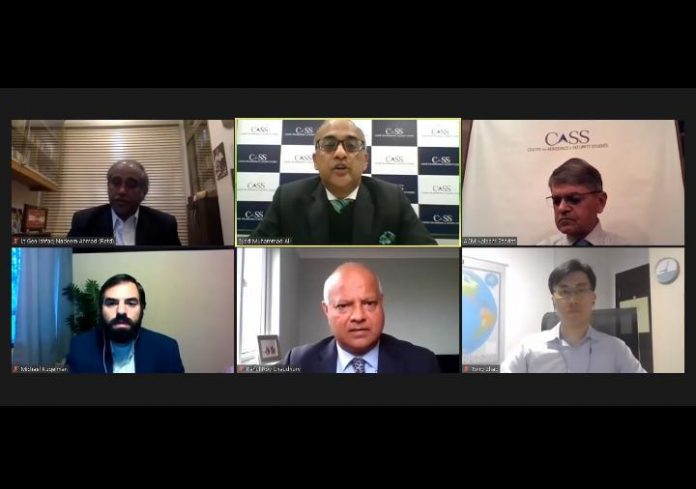DNA
ISLAMABAD: The world as a whole faces a lot of uncertainty, unpredictability, and instability. What is needed is global leadership, consensus, and flexibility. At the International Webinar on “Sino-India Border Clashes: Implications for South Asian Strategic Environment” organised by the Centre for Aerospace & Security Studies, here in the capital, an international panel of experts from China, Pakistan, United Kingdom, and the United States were of the view that:
- a) There is a severe perception gap between China and India. Both sides believe that their policies are purely defensive. However, despite their self-perceived defensive purposes, the current conflict is not going to end anytime soon.
- b) The United States is using a binding military strategy to ally with India against China gradually.
- c) Interdependence means China and India cannot afford to be enemies.
- d) India is only concerned with prestige, not with deterrence.
- e) Border disputes are unlikely to escalate to nuclear conflicts.
- f) Without an improvement in Indo-Pak relations, and to some extent, US-Iran relations, an important reason for instability though not the only one in Afghanistan, will continue to fester.
Mr Rahul Roy-Chaudhury, Senior Fellow for South Asia at the International Institute of Strategic Studies (IISS), London, believed that the recent violent border clashes between Indian and Chinese troops had resulted in a deterioration of bilateral relations between the two countries. This bad relationship could not be easily and nor quickly reversed. As a result of this, India’s existing competition with China in South Asia and the broader Indian Ocean Region was likely to sharpen into what he described as possible contestation in the defense and security domain. However, he opined that while India’s engagement in the QUAD was also going to increase, its focus would be broader than just defense and security. Mr Roy- Chaudhury noted that the increasing emphasis on defense policy was not risk–free for India. Therefore, it would ‘need to be imaginatively and sensitively applied by New Delhi, if it was to result in political and diplomatic dividends for the South Block’, he concluded.
Dr Tong Zhao, Senior Fellow, Carnegie-Tsinghua Center for Global Policy, Beijing, highlighted that there was a serious perception gap between China and India. From the Chinese perspective, India was trying to change the status quo across the region, especially given the 5 August 2019 revocation of the special status of Jammu and Kashmir and the public statement by Indian Home Minister Amit Shah who had declared in Lok Sabha last year that Aksai Chin was an integral and inseparable part of Jammu and Kashmir. Dr Zhao said such actions had triggered the Chinese military to show its resolve to protect the country’s national security. In contrast, India perceives that China has been changing the status quo across the border region. Both parties believe that their policies are purely defensive. Dr Zhao also predicted that the current conflict, despite both countries’ self-perceived defensive purposes, was not going to end anytime soon. According to Dr Zhao, President Xi Jinping has strong views on territorial issues and under his leadership, China would fight and not give up an inch of territory. He remarked that India’s aggressive move was encouraged by the US, but was not a major concern for China politically nor militarily. ‘Beijing is confident about the power gap between the two countries. Because of its military superiority, India won’t be able to make any gains on the ground.’ On the issue of nuclear deterrence, the Chinese analyst held that Indian nuclear modernization is driven more by the desire for prestige and domestic factors rather than because of China. As to why nuclear weapons had not played an important role in the Galwan Valley clash, Dr Zhao shared that China has a dismissive attitude about the relevance of nuclear weapons in China-India relations, which stems from the view that New Delhi’s indigenous military technologies are significantly behind theirs. However, he stressed that India might feel pressure to build up its nuclear arsenal, which could further threaten India and Pakistan’s fragile stability.
While evaluating the US’ role and stance on the Sino-India border clashes, Mr Michael Kugelman, Deputy Director and Senior Associate, Woodrow Wilson Center, Washington, DC, was of the view that the Ladakh crisis underscored growing Indian diplomatic problems in its backyard, putting New Delhi in hot water with both its top rivals – Pakistan and China. He warned that the South Asian environment was increasingly volatile, raising the prospects of miscalculation that could lead to a dangerous escalation. Mr Kugelman also pointed out that the Galwan crisis was not only impacting India and China; India-Pakistan relations would also be affected. ‘New Delhi and Islamabad are both worried that the other side could take advantage of the Ladakh crisis to harm the other.’
On the issue of mediation or actual involvement in case of any conflicting future situation between China and India, US intervention was not likely to happen unless India gave it security guarantees, he remarked. Discussing the significance of the South Asian region, Lt. Gen. (Retd.) Ishfaq Nadeem Ahmad, former Chief of General Staff, outlined that the region’s growth potential depended on reducing intra-regional disputes and its relations with the US. He said the latter looked at China as an emerging competitor, while China also sees US as a threat. ‘As long as China feels threatened by US, the region would remain constructively constrained.’ On the Sino-India border clashes, he shared that besides other implications, the psychological impact of the Ladakh conflict on all major regional states could not be ignored. The conflict proved that China had the ability to defeat India at a much lower scale. However, he also pointed out that both countries were unlikely to escalate to a broader level in Ladakh, in order to save their 90-billion dollar bilateral trade. Lt. Gen. Ahmad predicted that there was likely to be an ‘internationalist approach’ adopted by the new Biden administration, rather than an ‘isolationist one’ of Mr Trump. China’s view would also likely be in favor of regional stability given its economic activities in the region, even if it involved cooperation with Washington.

















